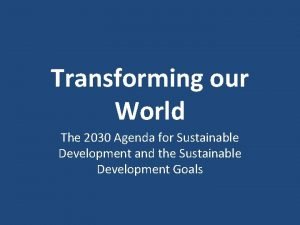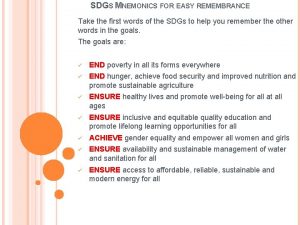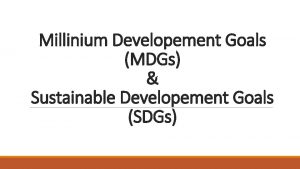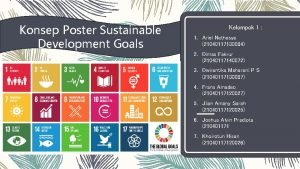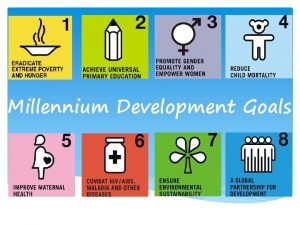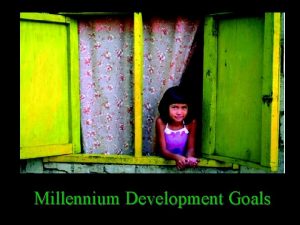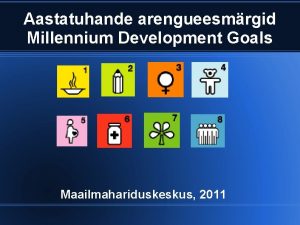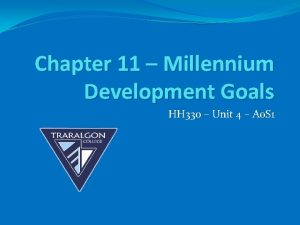Millennium development goals 11 Chapter 11 Key knowledge



















































- Slides: 51

Millennium development goals 11. Chapter 11

Key knowledge and skills. �Key Knowledge: �The UN’s 8 Millennium Development Goals (MDG’s) The name of each goal The purpose of each goal Reasons why each goal is important. �Key Skills: �Describe the eight UN’s Millennium Development Goals, their purpose and reasons why they are important �Evaluate the progress towards the MDG’s.

Intro. . �In 2000, members of the United Nations made a pledge to free the world’s citizens from extreme poverty. The measurable Millennium Development Goals (MDGs) and targets were set with an agreement made to try and achieve these by the year 2015. These achievable targets were commitments to improve the health and wellbeing of the world’s poorest people.

The Millennium Development Goals (MDGs) �The 8 Millennium Development Goals were developed by the UN in 2001 with the aim being to reach these goals by 2015. �The MDGs represent commitments from both developed and developing countries and are the first internationally agreed-upon framework for fighting global poverty, hunger, disease, illiteracy, environmental degradation and discrimination against women. �The MDGs work to see a reduction of the inequalities that create poverty and lead to global inequalities in health status and sustainable human development. �http: //www. youtube. com/watch? v=Sj 6 q 0 Apd_cs

The purpose of the MDGs �Goals and targets were set to help developing countries reduce poverty and hunger, to tackle ill health, gender inequality, lack of education, lack of access to clean water and environmental degradation, addressing the root causes of poverty and inequality with an achievement date of 2015. �The goals embody basic human rights: the right to health, education, shelter and security. �In addition to the eight goals, the UN also identified separate targets and indicators to measure progress and achievement in all areas. �The goals are ambitious but achievable and, together with the United Nations development agenda, set the course for the world’s efforts to alleviate extreme poverty by 2015. �http: //www. youtube. com/watch? v=Re. Rx 12 QUv 54

The Millennium Development Goals (MDGs)

Goal 1: Eradicate extreme poverty and hunger �Targets: � 1. Halve, between 1990 and 2015, the proportion of people whose income is less than $1. 25 a day. � 2. Achieve full and productive employment and decent work for all, including women and young people � 3. Halve the proportion who suffer from hunger. �http: //www. youtube. com/watch? v=aw. GKjq 2 e 9 E 8


Goal 1: Eradicate extreme poverty and hunger �In August 2008, the World Bank estimated that 1. 4 billion people in developing countries were living in extreme poverty, living on less than US$1 a day – that’s about 1 in 5 people. �Purpose of MDG 1: �Reduce the proportion of people whose income is less than $1. 25 a day, increase full and productive employment and decent work for all and to reduce the proportion of people who suffer from hunger.

Goal 1: Eradicate extreme poverty and hunger �Reasons why this goal is important: �Poverty significantly impacts rates of morbidity and mortality. �Without income people are unable to afford the most basic needs such as food, clean water and sanitation, adequate housing, healthcare and education. �Health status is improved with increased income as this provides greater access to healthcare and education, increased ability to provide food and shelter for the family and achieve their full potential. �Poverty reduces the ability of individuals and families to achieve good health and lead productive and meaningful lives and contribute to their community which reduces human development.

Goal 1: Eradicate extreme poverty and hunger �Progress so far: �Progress has shown extreme poverty has fallen in every developing region has seen the number of people living in extreme poverty and poverty rates fall �Proportion of people living on less than $1. 25 per day fell from 47% in 1990 to 24% in 2008. �However, hunger still remains a global challenge with 15. 5% of the world’s population still living in hunger.

�Activity 11. 2

Goal 2: Achieve universal primary education �Target: �Ensure that by 2015 children everywhere, boys and girls alike, will be able to complete a full course of primary schooling �http: //www. un. org/millenniumgoals/education. sht ml


Goal 2: Achieve universal primary education �Purpose of MDG 2: �The purpose of this goal is to ensure children everywhere, regardless of gender – boys and girls alike – are able to complete a full course of primary school education. �MDG 1 will not be achieved without improvements in this goal.

Goal 2: Achieve universal primary education �Reasons why this goal is important: �Education is a human right for every individual and is fundamental to ending poverty. �Improved education enables people to participate in their local community and have the opportunity of choice and be involved in activities that allows them to earn an income. �Too many children are denied the basic right to education, taking away the opportunity to make a better life for themselves. �Statistics show that young people who have completed a primary school education are less than half as likely to contract HIV as those who have not received an education.

Goal 2: Achieve universal primary education �Progress so far: �Increased rates of children enrolled in primary school, with girls benefiting the most. In developing countries the enrolment rate for children of primary school age rose from 82% to 90% �In 2010, the global primary school completion rate was 90%, compared to 81% in 1999. �Although many countries have made significant progress towards Goal 2, progress in some countries has been insufficient and as a result the target for this goal may not be met if these trends continue. �In 2010, 61 million primary-school-aged children were still out of school, with more than half of them living in sub. Saharan Africa and one fifth in Southern Asia.

Goal 2: Achieve universal primary education http: //www. youtube. com/watch? v=h. NBvt. M 1 hmz. Q

Goal 3: Promote gender equality and empower women �Target: �Eliminate gender disparity in primary and secondary education, preferably by 2005, and in all levels of education by no later than 2015 �http: //www. un. org/millenniumgoals/gender. shtml


Goal 3: Promote gender equality and empower women �Purpose of MDG 3: �To eliminate gender inequality in both primary and secondary education, increasing the ratio of girls to boys, and increasing the share of women in wage employment and also the proportion of women holding seats in national parliament.

Goal 3: Promote gender equality and empower women � Reasons why this goal is important: � Many women in developing countries lack equality. � 70% of those living in poverty are women. They do not have equal access to land, struggle with discrimination and experience financial insecurity and dependence. � 75% of children who are not in school are girls. This is a significant concern, especially given the influence girls and women have on their families. � Education is an important component in gender equality and female empowerment because it enables women to achieve economic, social and political equality. � Women who are empowered are able to positively contribute to their family. They have greater earning capacity, improve their access to education and also the education of their children and they have knowledge about the importance of health and healthcare. � Women can not only achieve sustainable human development for themselves but they also create the same opportunities for their family.

Goal 3: Promote gender equality and empower women � Progress so far: � The rate of progress in achieving this goal is concerning. � Girls’ primary education participation rates have increased in most regions. � Slow progress has been made in women’s share of paid jobs outside of the agricultural sector, from 35% in 1990 to 40% in 2010. � Women occupy 19. 7% of the seats in national parliaments, a slow progress has been seen in this area. � Although equal girls’ enrolment in primary school has been met or will be met by the deadline in all but Oceania, progress in all regions has been insufficient to achieve this goal if these trends continue. � Gender inequality and women’s empowerment are still key issues. Women continue to be discriminated against in access to education, work, financial assets and participation in government.

�Activity 11. 3 �http: //www. youtube. com/watch? v=TNj 4 n 8 RN 0 uo

Goal 4: Reduce child mortality. �Target: �Reduce by two-thirds, between 1990 and 2015, the under-five mortality rate �http: //www. un. org/millenniumgoals/childhealth. sht ml


Goal 4: Reduce child mortality. �It remains a global tragedy that a child’s chance of survival depends on where it is born, particularly as most of these deaths are from easily preventable or treatable causes. �Purpose of MDG 4: �The purpose of this goal is to reduce the under-five mortality rate and infant mortality by 2/3 and increase the proportion of one-year-old children immunised against measles.

Goal 4: Reduce child mortality. � Reasons why this goal is important: � In developing countries, 15% of children will not reach their fifth birthday, compared with 8% of children from developed countries. � Children born to women who have received a secondary school education are twice as likely to survive when compared to children from uneducated mothers. � By reducing child mortality and improving the health of children, life expectancy will increase and children will be able to attend school; take part in activities, such as play; and lead healthy and productive lives. � As a result, parents are able to work and increase the family’s income, rather than looking after sick children.

Goal 4: Reduce child mortality. �Progress so far: �Even accounting for population growth, the number of under-five deaths fell from 12. 4 million in 1990 to 7. 6 million worldwide in 2010. �Progress in achieving this goal is hopeful with 5 of the 9 regions reducing their under 5 mortality rate by more than 50%. �While U 5 deaths are declining, the number occurring during the neonatal period (first month after birth) is increasing. �Although majority of regions are on track to reducing their U 5 MR by 50% or more, progress in other regions has not been so successful. �As a result, it is unlikely this goal will be achieved by 2015.

�Activity 11. 4

Goal 5: Improve maternal health �Target: �Reduce by three-quarters, between 1990 and 2015, the maternal mortality ratio.

Goal 5: Improve maternal health �Every year, 500 000 women in developing countries die from pregnancy-related complications and 30 times more women suffer from pregnancy-related conditions. �Purpose of MDG 5: �Reduce the maternal mortality ratio, increase the proportion of births attended by skilled health personnel and achieve universal access to reproductive health.

Goal 5: Improve maternal health �Reasons why this goal is important: �In the sub-Saharan African region, the risk of a woman dying during pregnancy is 1 in 16, but for women in the developed world, this risk is only 1 in 3800. �Most maternal deaths are preventable. �Lack of access to healthcare increases the health risks of both the mother and baby during pregnancy. �Because many women experience gender inequality, they are more likely to not be educated; lack knowledge of the importance of healthcare, especially during and after pregnancy; suffer undernutrition and experience ill health.

Goal 5: Improve maternal health � Progress so far: �Maternal mortality levels have nearly halved since 1990, but are still a long way from reaching the 2015 target. �The proportion of deliveries attended by skilled personnel has increased. (55 -65%) �Antenatal care, which is a key intervention strategy for reducing mortality and morbidity, has also increased in developing countries. However, almost half of pregnant women in developing regions did not have the 4 recommended visits.

Goal 5: Improve maternal health �Activity 11. 5 pg 393

Goal 6: Combat HIV/AIDS, malaria and other diseases �Target: � 1. Have halted by 2015 and begun to reverse the spread of HIV/AIDS. � 2. Achieve, by 2010, universal access to treatment for HIV/AIDS for all those who need it � 3. Have halted by 2015 and begun to reverse the incidence of malaria and other major diseases

Goal 6: Combat HIV/AIDS, malaria and other diseases �HIV/AIDS, malaria and turberculosis (TB) are significant challenges to global health and development. These diseases claim more than 6 million lives every year. �Purpose of MDG 5: �The purpose of this goal is to reduce and reverse the spread of HIV/AIDS, malaria and other major diseases and ensure universal access to HIV/AIDS treatment for those who need it.

Goal 6: Combat HIV/AIDS, malaria and other diseases � Reasons why this goal is important: �The effects of these diseases are far reaching and have an impact beyond the individual. �People who are sick are unable to earn an income, they have poorer nutrition and less access to healthcare housing and education. �Good health and the absence of disease results in increased income, access to nutritious foods, adequate housing and education- which results in reduced need for aid an overall better quality of life. �By reducing the rates of HIV or other diseases, life expectancy increases, and people are able to contribute to their community and lead healthy and productive lives.

Goal 6: Combat HIV/AIDS, malaria and other diseases �Progress so far: �HIV infections, malaria and other disease rates have all decreased. �A greater level of funding, advertising and healthcare services available targeting these diseases is behind the drop in these rates. �Despite the progress, malaria still kills one child every 45 seconds. �Although there have been improvements in this goal, like the other goals, we are still a long way from reaching the 2015 target.

Number of people living with HIV, number of people newly infected with HIV and number of AIDS deaths in the world (millions), 1990– 2010

Goal 7: Ensure environmental sustainability �Targets: � 1. Integrate the principles of sustainable development into country policies and programs and reverse the loss of environmental resources � 2. Reduce biodiversity loss, achieving, by 2010, a significant reduction in the rate of loss � 3. Halve, by 2015, the proportion of people without sustainable access to safe drinking water and basic sanitation � 4. By 2020, to have achieved a significant improvement in the lives of at least 100 million slum dwellers

Goal 7: Ensure environmental sustainability �Purpose of MDG 7: �The purpose of this goal is to significantly increase the proportion of people with sustainable access to safe drinking water and basic sanitation, ensure the focus and principles of sustainable development are incorporated into the policies and programs of countries, and decrease the rate and reduction of environmental resource and biodiversity loss. �Biodiversity The variety of living organisms on the Earth-plants and animals.

Goal 7: Ensure environmental sustainability �Reasons why this goal is important: �Healthy people cannot exist without a healthy and sustainable environment. � 20% of the world’s population does not have access to safe and sufficient drinking water. �Without improvement in this area, the poverty cycle cannot be broken; and the other goals and sustainable HD will not be achievable. �Without access to safe water, sanitation and safe housing, people will not experience good health. As with all illnesses, when sick they are unable to work and earn a living, and access to education, food and healthcare is reduced, resulting in an inability to lead a healthy, fulfilling and productive life.

Goal 7: Ensure environmental sustainability � Progress so far: �The MDG drinking target has been met. In 2010, 89% of the world’s population was using improved drinking water sources. �Sanitation levels have also increased to 56% in 2010 from 36% in 1990. �Almost half of the population in developing regions, 2. 5 billion people, still lack access to improved sanitation facilities. � 783 million people (11% of the global population) still have no access to improved sources of drinking water.

Goal 8: Develop a global partnership for development � Targets: � 1. Develop further an open, rule-based, predictable, non-discriminatory trading � � � and financial system (this includes a commitment to good governance, development and poverty reduction) 2. Address the special needs of the least developed countries (includes quota-free exports for the least developed countries’ and debt relief for heavily indebted poor countries) 3. Address the special needs of landlocked developing countries and small island developing states 4. Deal comprehensively with the debt problems of developing countries through national and international measures in order to make debt sustainable in the long term 5. In cooperation with pharmaceutical companies, provide access to affordable essential drugs in developing countries 6. In cooperation with the private sector, make available the benefits of new technologies, especially information and communications

Goal 8: Develop a global partnership for development �Purpose of MDG 8 �For all countries, both developed and developing, to pledge their support for global partnership. This includes improving official development assistance, providing debt relief to developing countries, making available the benefits of new technologies, increasing access to affordable, essential drugs and improving market access.

Goal 8: Develop a global partnership for development �Reasons why this goal is important: �Unless developed countries improve aid, reduce debt relief and participate in fair trade, developing countries will never be in the position to improve. �All of this, particularly reducing debt, will allow for more money to be spent on other important matters such as building good governance, removing barriers to services and providing for the country’s people. All of which to improve the health and quality of life for all.

Goal 8: Develop a global partnership for development � Progress so far: �Progress in achieving this goal is hopeful with 6 of the 9 regions having either met or being expected to meet this goal by 2015. �However, given not all regions are showing good progress it is unlikely that this goal will be achieved. �Aid continues to concentrate on the poorest countries; however, spend amount has reduced. �Predictions suggest incoming aid will slow down from 2013 as developed countries face their own financial crisis.

Goal 8: Develop a global partnership for development �Activity 11. 6 (pg 400) parity

�Go through p. point on the 8 goals. �Split students into groups, research 1 goal each (about the goal, why its been included/important, purpose and progress) and present to class. �Students then complete a summary page/booklet (either book in bonnie’s folder or page on unit 4 revision doc) on the 8 goals.

�Table 8. 1 from unit 3 and 4 notes book
 Millennium development goals conclusion
Millennium development goals conclusion Strategic goals tactical goals operational goals
Strategic goals tactical goals operational goals Strategic goals tactical goals operational goals
Strategic goals tactical goals operational goals Millennium goals 2000
Millennium goals 2000 Millennium goals 2000
Millennium goals 2000 Millennium goals 2000
Millennium goals 2000 Chapter 26 section 1 the 1990s and the new millennium
Chapter 26 section 1 the 1990s and the new millennium General goals and specific goals
General goals and specific goals Motivation in consumer behaviour
Motivation in consumer behaviour Millennium geospatial
Millennium geospatial Third millennium
Third millennium Millennium prize problems
Millennium prize problems Millennium ecosystem assessment synthesis report
Millennium ecosystem assessment synthesis report Innopac millennium
Innopac millennium Poincare conjecture solver
Poincare conjecture solver Ava fontaine
Ava fontaine Millennium science complex
Millennium science complex Financial service partners
Financial service partners Millennium ecosystem assessment
Millennium ecosystem assessment Differnt tones
Differnt tones Millennium
Millennium Millennium
Millennium Millennium clock tower edinburgh
Millennium clock tower edinburgh Millennium planters
Millennium planters Millennium
Millennium Us digital millennium copyright act autumn
Us digital millennium copyright act autumn Biotechnology science for the new millennium
Biotechnology science for the new millennium Tacholink
Tacholink Millennium insurance
Millennium insurance Millennium assessment report
Millennium assessment report Sir gawain and the green knight historical context
Sir gawain and the green knight historical context Millennium ecosystem assessment
Millennium ecosystem assessment Städtereisen nodo district
Städtereisen nodo district Millennium scholars program
Millennium scholars program Example of business model canvas
Example of business model canvas Key partners key activities key resources
Key partners key activities key resources Personal and shared knowledge
Personal and shared knowledge Knowledge shared is knowledge squared meaning
Knowledge shared is knowledge squared meaning Knowledge shared is knowledge multiplied
Knowledge shared is knowledge multiplied Knowledge creation and knowledge architecture
Knowledge creation and knowledge architecture Contoh shallow knowledge dan deep knowledge
Contoh shallow knowledge dan deep knowledge A priori and a posteriori knowledge
A priori and a posteriori knowledge Book smarts definition
Book smarts definition Knowledge and knower
Knowledge and knower Gertler econ
Gertler econ Ap human geography
Ap human geography Mnemonic for sdg goals
Mnemonic for sdg goals Sustainability developement goals
Sustainability developement goals Un sustainable development goals
Un sustainable development goals Un 2015 sustainable development goals
Un 2015 sustainable development goals Poster sustainable development goals
Poster sustainable development goals Suistainable development goals
Suistainable development goals



